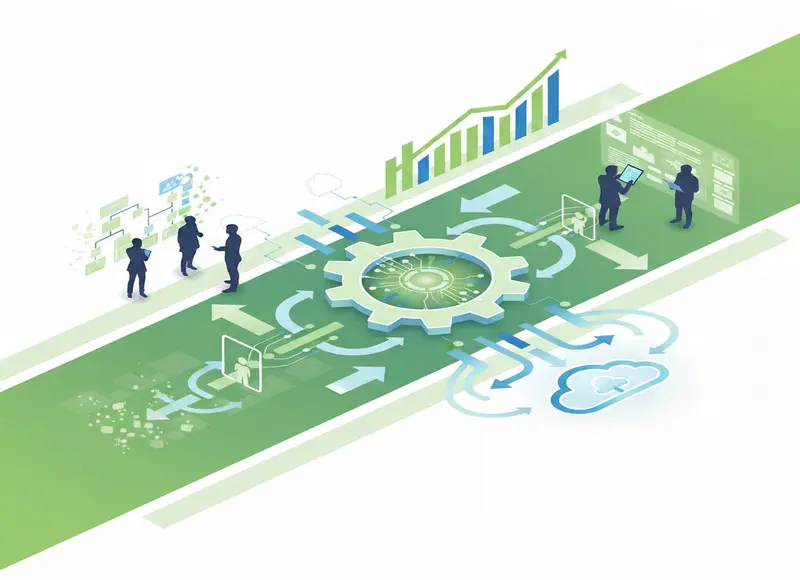Table of Contents
Augmented reality frameworks are used in multiple industries for a multitude of work. This article covers ample frameworks available in the technological world for augmented reality app development.

Augmented Reality is known to convert science fiction into reality any day. As a result, augmented reality programming is the most trending and buzzing terminology in the world of technology. Every person is aware of augmented Reality, including kids as well.
Augmented reality frameworks are used in multiple industries for a multitude of work. For example, it is used in industries like Aerospace & Defense, Electronics, Manufacturing, Gaming, Automotive, Medical, and Food & Beverage. In the HVAC industry, HVAC estimation software could integrate with augmented reality to provide detailed project insights, much like AR's application in other industries.
In the manufacturing Industry, Augmented reality applications can help you in areas such as Training, test & inspection, assembly, Distributed Manufacturing, Maintenance, and Part Picking & Kitting for bringing in product variations, quality assurance, and implementing many more tasks.
History of Augmented Reality
The history and evolution of Augmented Reality date back to the late 90s. Going back to the 1960s, Ivan Sutherland created an AR head-mounted device named Sword of Damocles. Then a researcher of Boeing in 1990, Mr Tom Caudell, named it Augmented Reality.
This technology kept evolving with time, and in 1992, the US Air Force Research Laboratory designed a fully immersive AR System like the game realities each child plays today.
What is Augmented Reality?
A report by Statista says that globally the market of augmented Reality (AR), Virtual Reality (VR), and mixed Reality (MR) has reached 28 billion US dollars in 2021, which is expected to rise to 250 billion US dollars by 2028.
AR tools are attracted by many big MNCs like Google, Apple, Facebook, and many other smaller businesses.
A quote by Scott Belsky -
"Well, we believe that augmented Reality is one of those new mediums that could be as big as, if not bigger than, the web. One of the areas where consumers adopt something new is when it makes something drastically easier. So when I think about augmented Reality, I think about instances like finding your way somewhere, finding your friends in a stadium, or going to a conference and looking around and knowing who everyone is because their LinkedIn profile is hanging over their heads."
Augmented Reality focuses on creating an interactive live experience of a world that combines computer-generated objects and the real-world environment. In Augmented Reality applications, virtual objects are overlaid in real-world environments to get the look and feel of how things would look with visuals, audio, haptic and somatosensory.
Augmented Reality is the technology where real-world objects and environments are replaced with 3D virtual objects with the help of AR devices. The beauty lies when these virtual worlds and objects blend to create a real-time experience for humans.
In virtual Reality, the images and objects are recreated and replaced, whereas artificial reality apps augment the same image of the real world with computer-generated digital images. The best-augmented reality app changes the scenario by enhancing them with digital details and adding video, infographics, sound, images, etc.
Let's dive deep into some of the examples:
You must have noticed the yellow line portrayed in an American football game, which moves down the field. Yes, that happened due to augmented reality frameworks and augmented reality applications.
Gatwick airport, also known as London Airport, won the award-winning passenger app for its creativity using the Augmented reality framework. As the airport has more than 2000 beacons, the passengers use AR maps to navigate the airport to different terminals. This app can also help control the airport's traffic in the future.
The medical field also has seen a massive transformation with the help of Augmented reality frameworks. It has helped in handling complex situations of patients for their surgeries as technology has enabled patients with proper treatments and diagnoses by surgeons, neurologists, and chemotherapists across the globe. The body part treated is generally a brain, a heart, ears, lungs, etc., which is analyzed, then an end-to-end structure is defined with proper margins, and shapes are also identified in case of a tumor.
That body part could be your brain, ear, heart, or lungs. You may wonder how medical professionals make such a diagnosis – they use AR applications to determine the disease's end-to-end structure, margins, or shapes, like a tumor or cancer.
For instance, let's talk about Pokémon Go. They instilled a Pokémon character when you open its AR app. They superimposed a digital character wherever you place your phone. Isn't that amazing and fascinating.
Another great example is Snapchat and B12 applications. It has out-of-the-box filters to augment our looks. For example, do you remember the bunny look on Snapchat for the social media photo? How many of you have tried clicking the picture with bunny ears on you and posted it on social media to look creative and add some fun to your life.
For kids, if you google the most popular dinosaurs, you will come across names such as tyrannosaurus. Then, you can use your phone to superimpose the tyrannosaurus into your room which looks close to Reality, using the best-augmented reality app. Sounds crazy, right?
You can use artificial reality apps to try different kinds of makeup or accessories for a birthday party look, a traveling look, or just for fun.
If you had placed an order for a piece of furniture and realized when you placed it at your home that it doesn't suit your home or fit in your area, it becomes life's biggest disappointment. To resolve this disappointment and let people shop confidently, Ikea introduced the Ikea Place app with the help of Apple's ARkit technology. This app helped the shoppers scan the room and place the objects to their liking.
Technology has advanced so much that you can virtually place Ikea furniture into your house and see how it would look or fit into your designated area. You can even check the wall paint color with the help of smart devices using Ar technology. In addition, you can visualize which color would go with which piece of furniture in your room by scanning your wall with your smartphone.
In 2017, Multinational companies such as Apple launched ARkit and Google launched ARCore for Android. Both of these were powerful app development tools for creating artificial reality apps.
AR does sound similar to mixed Reality because, in AR, the perception of the real world is knitted with the virtual world. The real-world scene or location is substituted in the virtual world with a simulated one.
"I think that a significant portion of the population of developed countries, and eventually all countries, will have AR experiences every day, almost like eating three meals a day. It will become that much a part of you." —Tim Cook.
Advantages of Augmented Reality
- Offers unique user experience to each one of them
- A great learning tool for developers to develop augmented reality apps
- Reduces cognitive overload as it neatly summarizes the digital snippets
- Visualizing objects in a real-world environment is fascinating.
- It can be used for different industries.
- Scope of constant improvement
- Increases the scope of user engagement for a brand or industry
- Produces accurate results
- Builds real-time experience in the gaming environment
- It is very useful for medical students; they can perform surgeries and cure injuries using Ar and VR simulations without spending much and getting experience in real-life situations.
- Introducing virtual fitting rooms enhances purchase decisions and reduces the rate of return policies.
- It can prove helpful to the astronauts as they can try their first or next space mission.
What is an AR application?
Augmented reality in app and web development has become the prime focus and one of the most immersive technologies when one talks about app development tools in today's era.
To develop augmented reality apps, you need to choose two types of bifurcation: Location apps and marker-based apps.
What is a marker-based application?
In marker-based recognition, image recognition takes place. The AR content is displayed using black and white markers on the screen. When one needs to see the augmented component, the camera is pointed to the marker's position. Once the point is recognized, the augmented object is seen.
The images or objects are given beforehand in a marker-based application to simplify the process of searching or detecting them.
Location-based applications
There is no use of a marker-based application here. In this case, the object or user's position is identified with the help of GPS, an accelerometer, or a digital compass. The augmented reality objects are placed on top of physical spaces to get a real feel of the environment, a large animal, or something like Pokemon for children's fun.
An application like Pokemon Go notifies people of objects suitable for their location. For instance, a location-based app can recommend nearby cafes and bars.
Augmented reality frameworks
There are ample frameworks available in the technological world for augmented reality app development. However, choosing the right framework is crucial and time-consuming to build a good web design for your business.
Many factors must be considered when choosing the best framework for a responsive web design. The current augmented reality framework has many differences in performance. Some focus on identifying graphic markers such as QR codes from the top QR code generator and other images, others are used for GPS, and others may combine.
Let's understand the various types of frameworks:
1.ARCore
Google developed this awesome AR technology to support Android against what Apple created as ArKit to support IOS. ARCore focuses on three key technologies to embed virtual images and objects into the real environment: motion tracking, lighting recognition, and environmental recognition.
With the help of various APIs, ARCore helps the smartphone sense the environment and its surroundings and interact with the information.
ArCore's 3D model can react to changes in lighting and volume and come up with different shades of color. So just moving the smartphone from left to right or top to bottom does not change the situation or objects or define the parameters of those physical objects. Instead, the objects created are automatically placed on table tops, floors, or other environmental surfaces.
Do you know which ARCor is supported by which platforms?
- Android 7.0+
- iOS 11+
- Android NDK
- Unity for Android
- Unity for iOS
- Unreal Engine
In Hybrid app development, this kind of software development kit understands various aspects of the tool, such as adjusting the light for the virtual objects and tracking the phone's motion. Its position is based on the surrounding objects. Placing texts or determining the size and the location of a certain object is determined by ARCore while working with Java/OpenGL, Unreal, and Unity.
2. ARKit
To dive deep into the augmented reality world and build an unparalleled experience for IOS and iPadOS users, Apple launched the biggest platform known as ARKit and RealityKit. The ARKit framework is so popular and strong that, along with creative tools such as Reality Composer and Reality Converter, bringing ideas to life in the AR world became super easy.
Developers have focused on building and designing augmented reality app development efficiently for users to interact with the real world with real-time data collected from devices, sensors, and cameras.
Apple has launched ARkit 6, which talks about 4K videos. This feature captures high-resolution videos that can be used for professional editing, film production, social media apps, and much more. In addition, the feature has expanded its capabilities, supporting HDR Video and capturing high-resolution images during the ARkit session.
ARkit has a strong feature of creating a topological map of space. It identifies the floors, walls, ceilings, windows, doors, etc. Such deep understanding removes the obstacles of object occlusion and virtual objects for the real world.
The developers can use this SDK to create mobile software for a responsive web design for iPhones and iPads. In addition, it helps in presenting an exclusive AR technology for the devices.
In Apple, Reality composer is used for iOS, iPadOS, and macOS, which makes the process easy to build, test, tune and simulate the AR experiences for the user. It enables you to move quickly from one device to another or switch between Mac and iPhone or Mac and iPad to create amazing experiences in the app. It also helps in facial recognition.
3. Vuforia
This platform has emerged as the most potential Augmented Reality framework. Here the device's screen is used as the lens to interweave the objects and images of the real world and the virtual world. In addition, Vuforia has the feature to recognize both 3D objects and flat objects in real time.
It is considered one of the most used frameworks for developing augmented reality apps and has the feature of creating backgrounds, buttons, and effects.
This framework was introduced by Qualcomm (a company that specializes in the research and development of wireless means of communication and SOC electronic microchips)
Vuforia has a QCAR library containing an image, cubes, cuboids, cylinders, word targets, frame markers, and image rendering features. The various solutions created with Vuforia are supported by iOS, Android, Unity Editor, and Universal Windows Platform. In addition, it offers an Object Scanner while recognizing 2D and 3D objects, text recognition with a built-in dictionary of 10K English vocabulary words, and an option to create a customized one. Vuforia also provides the feature of barcode scanning, buttons that can convert any surface into a touchscreen, smart glass support, etc.
4. Unity3D
Unity3D is one of the leading platforms for creating and operating interactive real-time 3D content for various devices. It is the most sought-after game development engine that can be launched across iOS, Android, Xbox, PlayStation, Nintendo, Windows PC, Mac, VR devices, and many more.
Whether you have a small business or a huge business, unity3D can efficiently build AR games across mobile, PC, or console.
This augmented reality framework has a whooping 5B number of downloads per month of apps built with Unity3D.
You will be surprised to know that around 72% of the best 1000 mobile games worldwide are made with the help of Unity.
Unity provides Augmented reality programming solutions for Games, enterprises, automotive, transportation, manufacturing, art industry, film, animation and cinematics, aerospace, architecture, engineering and construction, branding, ed tech, etc.
To enable the digital transformation of your business, they also equip you with the tools to build a metaverse. For example, they connect players at scale in the gaming industry and help monetize the app with immersive advanced technology.
Its immersive CGIs require less coding and a designing expert in Unity3D. It is the next level in the world of Gaming. You will be surprised that most AR frameworks have integrated tools and extensions for Unity3D.
5. MaxST
MaxST is another powerful augmented reality framework for mobile application software development companies and developers. MaxST comprises five major components, namely.
- Image tracker- here, it tracks planar circuits of an image, namely standard size image, extended image that gets maximum covered in the camera's vision, and multi-image, which tracks up to three objects.
- Visual SLAM helps create and save the three-dimensional map that extends beyond the initial frame, generally occurring when the camera moves from one place to another.
- Instant tracker - here, it recognizes a flat platform and places the 3D object over it.
- Object tracker - helps load the map file and place the 3D objects over it.
- QR/Barcode Scanner - recognizes the QR codes and barcodes instantly.
If we talk about the compatibility of MaxST, it goes with platforms such as iOS, Android, Mac OS, and Windows.
MaxSt generally has two kinds of SDKs- a 2D toolkit that tracks images and a 3D toolkit that scans and recognizes the surrounding environment. The current news is that Metaverse is coming with MaxST.
6. Unreal Engine
Unreal Engine is the world's most advanced real-time 3D creation tool. It provides industry solutions for Games, Architecture, Film & Television, Broadcast & live events, Animation, automotive & transportation, and simulation.
Big and amazing games have been introduced with Unreal Engine, which has been the guiding light behind many movie CGIs. It provides virtual production, human-machine interface, Extended Reality (XR), and many more places for limitless potential.
Unreal Engine supports DCC, CAD, and BIM formats for 3D assets, including 3D Max, Cinema 4D, FBX, USD, SketchUp Pro, etc.
Unreal Engine has all the elements to build the most immersive AR technology and has the potential to deal with any complex situation.
8. Simple CV
Simple CV is yet another Augmented Reality framework used by several developers in Hybrid App Development. A simple CV combines actual objects in the real world and virtual items you see on the screen.
Simple CV is compatible with Java, C++, and Python. Its visual functionality includes the edge technique, the key point search tool, and more
9. Kudan
Kudan is famous for its speed and its feature of quickly recognizing objects and posters or stickers. In addition, due to Kudan's easy functionality, access to a purchasing or payment confirmation feature is done automatically with Kudan's feature.
For Kudan to work accurately, a layer is added to the actual item. This augmented reality framework is used for individual projects wanting to develop augmented reality products. It is available at an extra cost and license if you need extra functionalities.
Kudan SDK helps track the location, 2D and 3D image recognition, flexible integration, sensors for detecting light sources, etc.
Conclusion
Augmented Reality is the future in the world of app development. Therefore, it is essential to factor companies into their sector. You see, many options of Augmented Reality frameworks exist in the market to build augmented reality applications. Furthermore, mobile application development businesses have bridged the gap between the real and artificial worlds due to the significant use of AR technology.
Every single framework discussed above can come up with innovative and amazing solutions. The integration and adoption happen as per the use case of the application. The world is advancing to the next level; in the future, everything around us will be AR and AI-operated.
If you are seeking faster growth and success, the chances of using AR technology can increase the success rate with the help of mobile applications.









